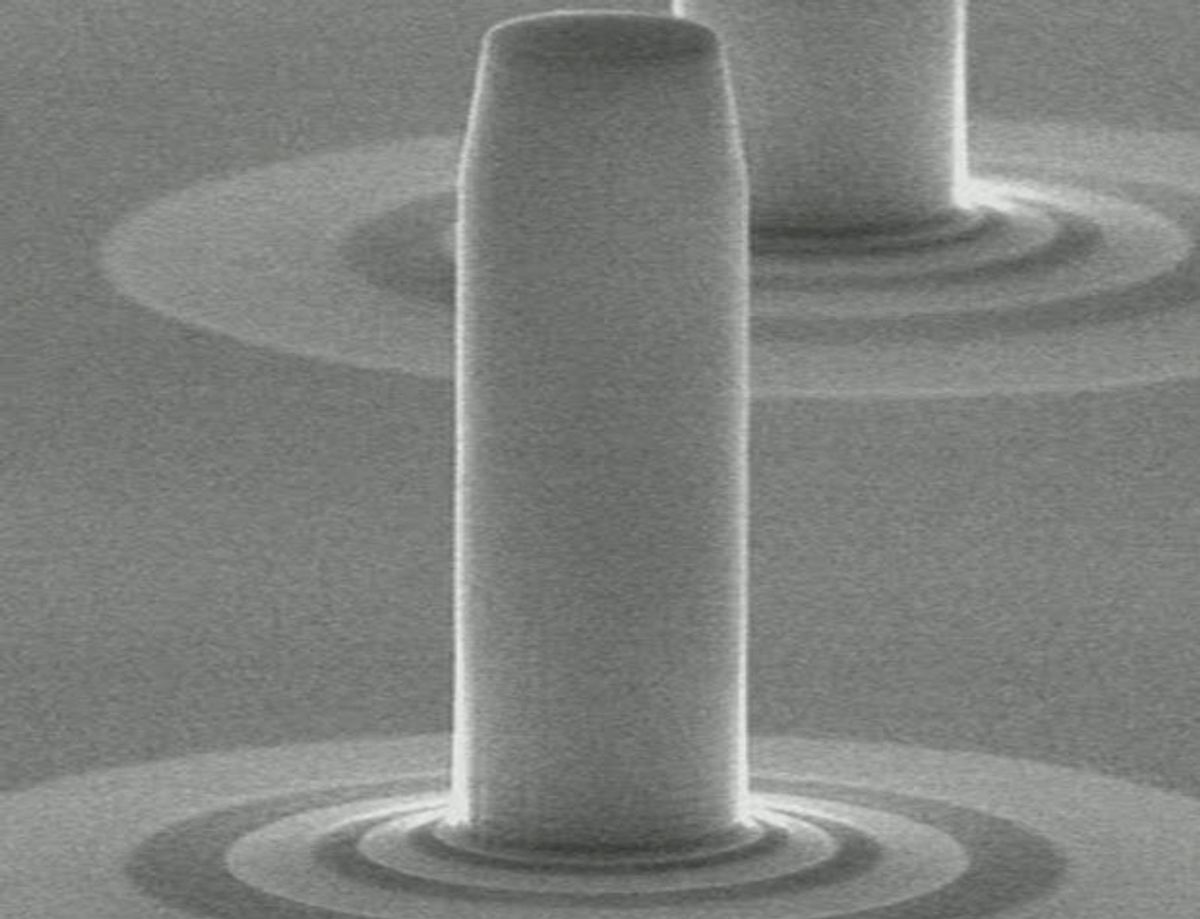
A new type of laser has the potential to be much more energy efficient than conventional lasers, according to two groups of scientists who separately came up with very similar designs for it.
Known as a polariton laser, the device isn’t, strictly speaking, a laser at all. Conventional lasers work through stimulated emission of radiation: Electrons in a laser cavity are raised to a high-energy state, and when they drop to a lower state, they emit the excess energy as photons, producing a coherent beam of light.
This new device, however, is based on the stimulated scattering of polaritons. A polariton is a “quasiparticle,” a mixture of an electron-hole pair (also known as an exciton) and a photon, which can exist only within a crystal. When energy is pumped into the system, the exciton-polaritons absorb it and then quickly release it as photons—the stimulated scattering that creates the laser beam. In a conventional laser, the majority of electrons must be in a high-energy state before lasing can begin. Such a “population inversion” isn’t required with polariton lasers, so it takes less energy to run them.
Since 1996, when the concept was first described, researchers have built polariton lasers that used light from other lasers to pump energy into the system. Now two groups, working independently, have built devices that run on electricity, a key step in turning any laser from a laboratory curiosity into something useful.
“This is a big deal,” says Pallab Bhattacharya, a professor of engineering at the University of Michigan, whose paper describing his team’s work appears online in Physical Review Letters on Wednesday. “A real device is one that is electrically injected. This makes it a practical device.”
“It is not a laser in the common sense, but it shares a lot of characteristics with the conventional laser,” says Sven Höfling, a researcher at the University of Würzberg, in Germany. He and colleagues from Iceland, Japan, Russia, Singapore, andthe United States published a paper on their work in Thursday’s issue of Nature.

One major difference between conventional and polariton lasers is that the lasing threshold—the amount of energy it takes to stimulate the light emission—is orders of magnitude lower in polariton lasers. Bhattacharya says these early prototypes have a threshold current of 12 amperes per square centimeter and will presumably improve. By comparison, he says, it took years of research to make advanced experimental lasers based on quantum dots—tiny clumps of semiconductor material—with a similar threshold current.
Polariton lasers can also be switched on and off much faster than conventional lasers can, Battacharya says, which allows signals to be encoded onto the laser beam very quickly. That means the laser might be useful for low-power (and therefore less-expensive) optical telecommunications and light amplification. Polariton lasers might also be used to trigger lasing at terahertz wavelengths. They could be used to build cheaper, more compact terahertz lasers, which could be a safer alternative to X-ray scanners in spectroscopy and security applications.
Alexey Kavokin, a physicist at the University of Southampton, in England, who is familiar with Höfling’s results, says polariton lasers might also be used in optical logic circuits. Because they can switch from on to off or the reverse in mere picoseconds, and because the polarization of their light might be controlled, polariton lasers would make excellent AND and NOT gates, he says. But these lasers have limits. For example, Kavokin says, they aren’t candidates for high-power applications, such as cutting and welding, because pumping more energy into them destroys the polaritons and thus ends the lasing effect.
Both groups’ lasers were built using gallium arsenide, and both use a magnetic field to make the scattering more efficient. Both also operate only at extremely low temperatures, on the order of 30 kelvin. Höfling says the next step in the research will be to try to build an electrically pumped polariton laser that operates at room temperature; optically pumped room-temperature versions already exist. The lasers are still at a fairly basic stage of research, he says, and it could be a long time before anyone builds a commercial polariton laser.
Both Höfling and Bhattacharya were surprised to learn of each other’s papers, which were released in the same week. “That’s a tremendous coincidence, and a big deal. We validate each other,” Bhattacharya says. “The two taken together, it’s a big boost for the field.”
About the Author
Neil Savage, based in Lowell, Mass., writes about strange semiconductors, unusual optoelectronics, and other things. In the April 2013 issue he reported on a breakthrough that could lead to a way to combined CT scanners and MRI machines.
Neil Savage is a freelance science and technology writer based in Lowell, Mass., and a frequent contributor to IEEE Spectrum. His topics of interest include photonics, physics, computing, materials science, and semiconductors. His most recent article, “Tiny Satellites Could Distribute Quantum Keys,” describes an experiment in which cryptographic keys were distributed from satellites released from the International Space Station. He serves on the steering committee of New England Science Writers.



